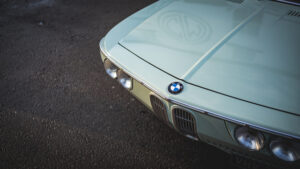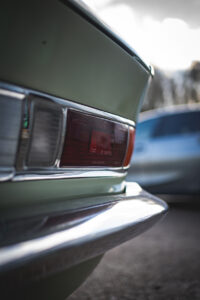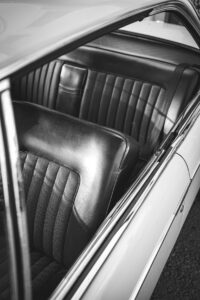BMW’s Neue Klasse cars of the 1960s were, as the name suggests, something new for the Bavarian firm. Despite its mid-century modernist looks, under the skin, this 2000CS is newer still.
Change was everywhere in the 1960s. The architecture, the fashion, the music, the technology – everything suddenly rushed forward with unbelievable pace. The car world took notice. Smooth, curvaceous lines and lavish amounts of chrome were suddenly out, and the upright, squared off shapes and less-is-more aesthetic that would define the best designs of the following two decades were beginning to assert themselves.
Few saw this coming as early as BMW. Before the ’60s, they made big, squidgy luxury cars with design traits firmly rooted in the interwar years, and licence-built versions of the tiny Iso Isetta bubble car. It was an ageing, disjointed range and the company needed something new if it was to survive into the new decade. And it needed it fast.
The answer arrived at the 1961 Frankfurt Motor Show. All clean, straight lines and sharp corners, the 1500 saloon heralded a new era for BMW. It introduced design elements like the forward-canted nose and Hofmeister kink – the tiny upward kick in the window line at the C-pillar – that would remain part of the Munich lexicon for decades. Together with the smaller 02 series it spawned, the 1500 helped lay out the technical blueprint for the 3 Series and 5 Series, cars that still form the absolute bedrock of the BMW range. It was such a departure for the brand that they named the range the Neue Klasse – the New Class.
It was all very worthy, and a hugely important moment in the history of the car, but with its upright stance, skinny tyres, and little 1.5-litre engine, it was a bit… unsexy. Enter the Neue Klasse coupé of 1965. From the front wheels backward, you’ll probably recognise it as the car that became the E9, the basis for the legendary 3.0 CSL ‘Batmobile’.
Things are a little different at the front, lead designer Wilhelm Hofmeister (of kink fame) taking a particularly blunt, angular approach to the nose. It’s a design that’s split opinion over the years, but now seems clean and pure in the rawness of its form, much in the way that lots of long-maligned 1960s brutalist architecture now seems to be coming of age.
Both versions of the Neue Klasse coupé – the 100bhp 2000C and 120bhp 2000CS – used the largest 2.0-litre version of BMW’s M10 four-cylinder engine. This car, a 1968 UK-supplied 2000CS, doesn’t, though: it’s been swapped out for an M44, the short-lived 1.9-litre four produced between 1996 and 2000 and used in the E36 318is, 318ti Compact and Z3. This takes power up to 138bhp and removes the hassle of carburettors, both helpful improvements in a car that owner James describes as ‘built to use’. Further modifications in this spirit include a 5-speed gearbox, electric power steering, and aluminium brake calipers.
The exterior, too, has seen some sympathetic updates. It’s a restoration job, the car having taken a nasty hit to the front right in a previous life. When repairing it, James took the opportunity for some visual tweaks, removing the front bumper and painting the headlight surrounds in body colour – originally, they were surrounded by unflattering unpainted metal on UK and US cars, and fully glassed-in in Europe. That paint, by the way, is Florida Green – a rare original option on the Neue Klasse coupé, but not this car’s original colour.
James is the first custodian of the 2000CS outside of the family that bought it new, and his comments about using it are more than just talk – it’s taken him and his son from their south Wales home to the south of France.
BMW is resurrecting the Neue Klasse name for its next generation of EVs, slated to arrive in 2025. It’s a bold statement of intent when the last use of the name heralded such a sea change for the company. Perhaps that’s what we’re set to see again, but for now, the old New Class stands as the foundations of BMW as we know it.
























